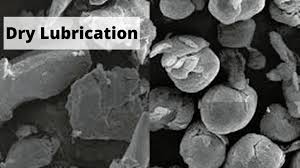
A Review Case on Dry Lubricants: PTFE and Graphite
Dry lubricants, such as Polytetrafluoroethylene (PTFE) and graphite, have revolutionized industries by providing effective lubrication without the need for liquid oils or greases. Known for their ability to reduce friction and wear, these materials are indispensable in applications where traditional lubricants fail due to extreme conditions or contamination concerns. This article explores the properties, applications, and advantages of PTFE and graphite as dry lubricants.
What are Dry Lubricants?
Dry lubricants are solid substances that reduce friction between surfaces in relative motion. They function by forming a thin, durable film that minimizes direct contact and wear. PTFE and graphite are among the most widely used dry lubricants due to their unique properties and versatility.
Properties of PTFE
- Low Friction Coefficient:
- PTFE, commonly known as Teflon, has one of the lowest coefficients of friction among solid materials.
- Chemical Resistance:
- Highly resistant to most chemicals, ensuring durability in harsh environments.
- Thermal Stability:
- Retains its properties across a broad temperature range (-200°C to 260°C).
- Non-Adhesive Surface:
- Prevents sticking, making it ideal for high-performance coatings.
Properties of Graphite
- Layered Structure:
- Composed of layers of carbon atoms, allowing easy sliding and reducing friction.
- Thermal Conductivity:
- Excellent at dissipating heat, beneficial in high-temperature applications.
- High Temperature Tolerance:
- Operates effectively at temperatures exceeding 500°C in inert or reducing environments.
- Electrical Conductivity:
- Conductive properties make it useful in applications requiring both lubrication and electrical performance.
Applications of PTFE and Graphite as Dry Lubricants
- Aerospace:
- Used in spacecraft and aircraft components where traditional lubricants may evaporate or degrade.
- Automotive:
- Reduces wear in engine components, bearings, and seals.
- Industrial Machinery:
- Applied in gears, chains, and conveyor systems to enhance performance and longevity.
- Electronics:
- Ensures smooth operation of electrical contacts and switches.
- Medical Devices:
- PTFE is commonly used in catheters and surgical instruments for its non-stick and biocompatible properties.
- Energy Sector:
- Graphite is used in nuclear reactors and high-temperature furnaces for its stability and conductivity.
- Food Processing:
- Both materials are used in FDA-approved applications due to their non-toxic and non-reactive nature.
Advantages of PTFE and Graphite
- Wide Operating Temperature Range:
- Perform well in extreme cold and heat.
- Reduced Maintenance:
- Long-lasting lubrication reduces the need for frequent reapplication.
- Clean and Dry Application:
- Ideal for environments sensitive to liquid contamination.
- Versatility:
- Suitable for a wide range of industries and applications.
Challenges in Using Dry Lubricants
- Cost:
- High-quality PTFE and graphite can be more expensive than traditional lubricants.
- Application Techniques:
- Requires precise methods for coating or incorporating into systems.
- Load Carrying Capacity:
- Limited ability to handle extremely high loads compared to some liquid lubricants.
Future Directions
- Nanotechnology Integration:
- Enhancing the properties of PTFE and graphite with nanomaterials for superior performance.
- Eco-Friendly Solutions:
- Developing sustainable and biodegradable dry lubricant formulations.
- Hybrid Lubricants:
- Combining PTFE and graphite with other materials to achieve multi-functional capabilities.
- Smart Lubrication Systems:
- Integrating sensors to monitor wear and lubrication effectiveness in real-time.
Conclusion
PTFE and graphite are pivotal in advancing the capabilities of dry lubrication. Their unique properties make them essential in demanding applications across industries. As research and technology progress, the development of enhanced and eco-friendly dry lubricants will continue to drive innovation and efficiency, ensuring their relevance in the future of material science and engineering.
